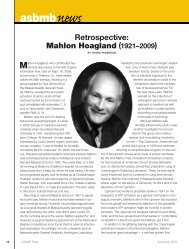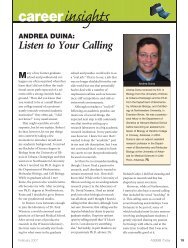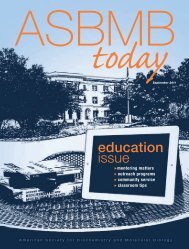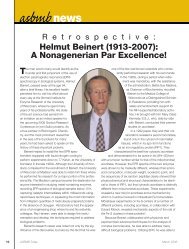View Program - asbmb
View Program - asbmb
View Program - asbmb
- TAGS
- program
- asbmb
- www.asbmb.org
You also want an ePaper? Increase the reach of your titles
YUMPU automatically turns print PDFs into web optimized ePapers that Google loves.
82<br />
Dissecting the roles of O-glycosylation and dimerization<br />
in the apical sorting of a model raft-independent protein<br />
Robert Youker 1 , Federick Lanni 2, 3 , Haibing Teng 3 , Ora Weisz 1 .<br />
Renal Electrolyte Division, Department of Medicine, University of Pittsburgh, Pittsburgh PA<br />
15261 1 , Department of Biological Sciences, Carnegie Mellon University, Pittsburgh PA 15213 2 ,<br />
Molecular Biosensor and Imaging Center, Carnegie Mellon University, Pittsburgh PA 15213 3 ,<br />
Abstract:<br />
Proteins sorted to the apical plasma membrane in polarized epithelial cells can be categorized<br />
into two classes based on their differential association with cholesterol and glycolipid-enriched<br />
membrane microdomains commonly termed “lipid rafts”. Our laboratory and others have<br />
previously demonstrated that lipid raft-associated and lipid raft-independent proteins take<br />
different routes to the apical surface (1, 2). Interestingly, raft-associated and raft-independent<br />
apical cargoes appear to be segregated into distinct subdomains even within the trans-Golgi<br />
network (TGN) (3). Moreover, TGN export requirements of the raft-independent protein p75<br />
assessed using an in vitro assay are markedly different from that of a raft-associated protein.<br />
Self-association or “clustering” is important for the sorting of raft-associated proteins but the<br />
role of clustering in raft-independent sorting is unclear. The apical sorting determinant in p75<br />
resides within its O-glycosylated stalk, and galectin-mediated crosslinking has been proposed as<br />
a sorting mechanism for this protein (4). Additionally, a novel dimerization motif (Cys257,<br />
A261XXXG266) has been identified in the transmembrane region of p75 that could contribute to<br />
the formation of oligomers (5). I have created a panel of p75 mutants to determine the roles of<br />
O-glycosylation and dimerization in the segregation and export characteristics of p75 staged in<br />
the TGN. In vitro TGN budding assays and immunofluorescence microscopy are being employed<br />
to examine segregation and TGN export of mutants compared with wild type p75. In addition<br />
the local cellular environment occupied by wild type and mutant proteins is being explored<br />
using biophysical approaches. 1) Cresawn, K. O. et al. (2007) EMBO J. 26, 3737-3748 2) Jacob,<br />
R., and Naim, H. Y. (2001) Curr. Biol. 11, 1444-1450 3) Guerriero, C. J. et al. (2008) JBC 283,<br />
18040-7 4) Delacour et al. (2007) Traffic 8, 379-388 5) Vilar, M. et al. (2009) Neuron 62, 72-83.






